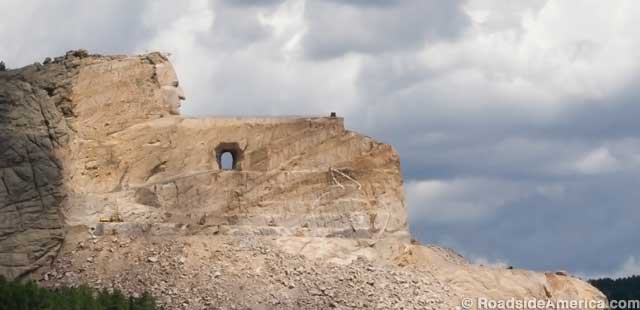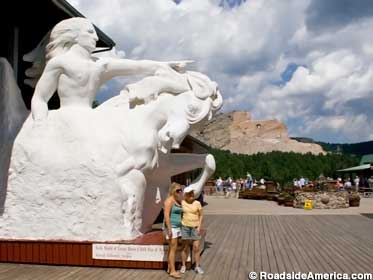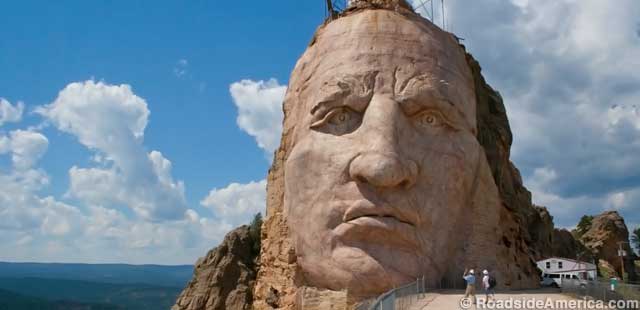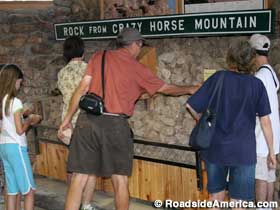
Crazy Horse Memorial
Crazy Horse, South Dakota
Chief Crazy Horse is crazy big. When we first saw this immense project, years ago, it was a ragged mountainside with a theoretical destiny set in the unknowable future. Now the sculpture has a giant head, and even simpletons like us can see that it's destined for the greatness achieved by all things too big to hide with a fence or tall shrubbery. Clouds race across its cheeks. Sunlight dapples its hairline.

Model of the completed sculpture.
Crazy Horse's head is bigger than the four heads down the road -- that gaggle of granite white men that formerly got all of the attention in the Black Hills. In fact, it's bigger than all four of those heads combined. And Chief Crazy Horse will eventually be much more than a head. Crazy Horse's handlers stress that the monument has a noble purpose, but anything built on such a super-sized scale has some Barnum in it. The intent of this, the World's Largest Sculpture, has always been in part to get attention.
It was begun in 1948 -- not by a relative of Crazy Horse, but by a Polish-American from Boston named Korczak Ziolkowski (KOR-chok shul-KOF-skee). He was chosen by a group of Lakota elders because he had worked at Mt Rushmore, and because he had won a sculpting prize at the 1939 New York World's Fair. And, also, because he was born 31 years to the day after Crazy Horse had been murdered. Odd criteria, maybe, but Korczak proved to be the perfect choice: he had grand plans, a strong back, and he was willing to devote the rest of his life to the project. When Korczak died in 1982, his wife and ten children continued the work. Now the grandchildren are blasting and jackhammering as well.

The head up close (this vantage point is not accessible 364 days a year).
Even from the Visitor's Center a mile away, Crazy Horse is huge. When finished -- and no one has any idea what century that will be in -- the sculpture will be 563 feet high and 641 feet long.
To get an up-close look at the head, you have to visit on the first full weekend in June, when tourists are allowed to walk the six miles to the top of the mountain and back (During the rest of the year, the closest that you can get to the head is a seat on a bus that drives you to the foot of the mountain). Crazy Horse's 88-foot-tall face looks dazed at a pimple's distance; his eyes are 18 feet across; his nostrils are each wider than some commercial cave entrances. Gigantic isn't necessarily flattering, but it also isn't the point.

Free rocks.
Most of the sculpting at Crazy Horse is done with dynamite, and progress is measured in tons of rock blown away per week. Blasts are planned for all major holidays during the non-blizzard months; otherwise visitors get 30 minutes notice before part of the mountain explodes. Elaborately choreographed night blasts mark Korczak and his wife's birthdays. A lightning strike on a truckload of nitro could mean bye-bye Crazy Horse, so ominous clouds usually bring an end to the days' work -- as does snow or a simple lack of cash. Despite offers of millions of dollars, the folks at Crazy Horse have refused all government funding. They explain that the U.S. has a bad record of keeping promises to Indians.
There's much more here than the giant sculpture, such as a museum of Korczak's old hammers and pickaxes, a gallery of his other artwork, and an Indian Museum of North America that Korczak and his family built one winter as an outlet for their unflagging energy. From a viewing veranda you can gauge progress on the mountain by comparing it to Korczak's 1/34 scale plaster model. And the last stop out the door is the "Rock Box," a large bin of chunks blasted from the mountain that visitors are free to take as souvenirs.
Crazy Horse is being sculpted into pegmatite granite, and no one knows how long it will all hold together. But odds are that when aliens reach earth after civilization has destroyed itself, the biggest man-made thing that they will find will be Crazy Horse. "This," they will say, "must have been the most important person on this planet." And Korczak and his Indian pals would have made their point.





